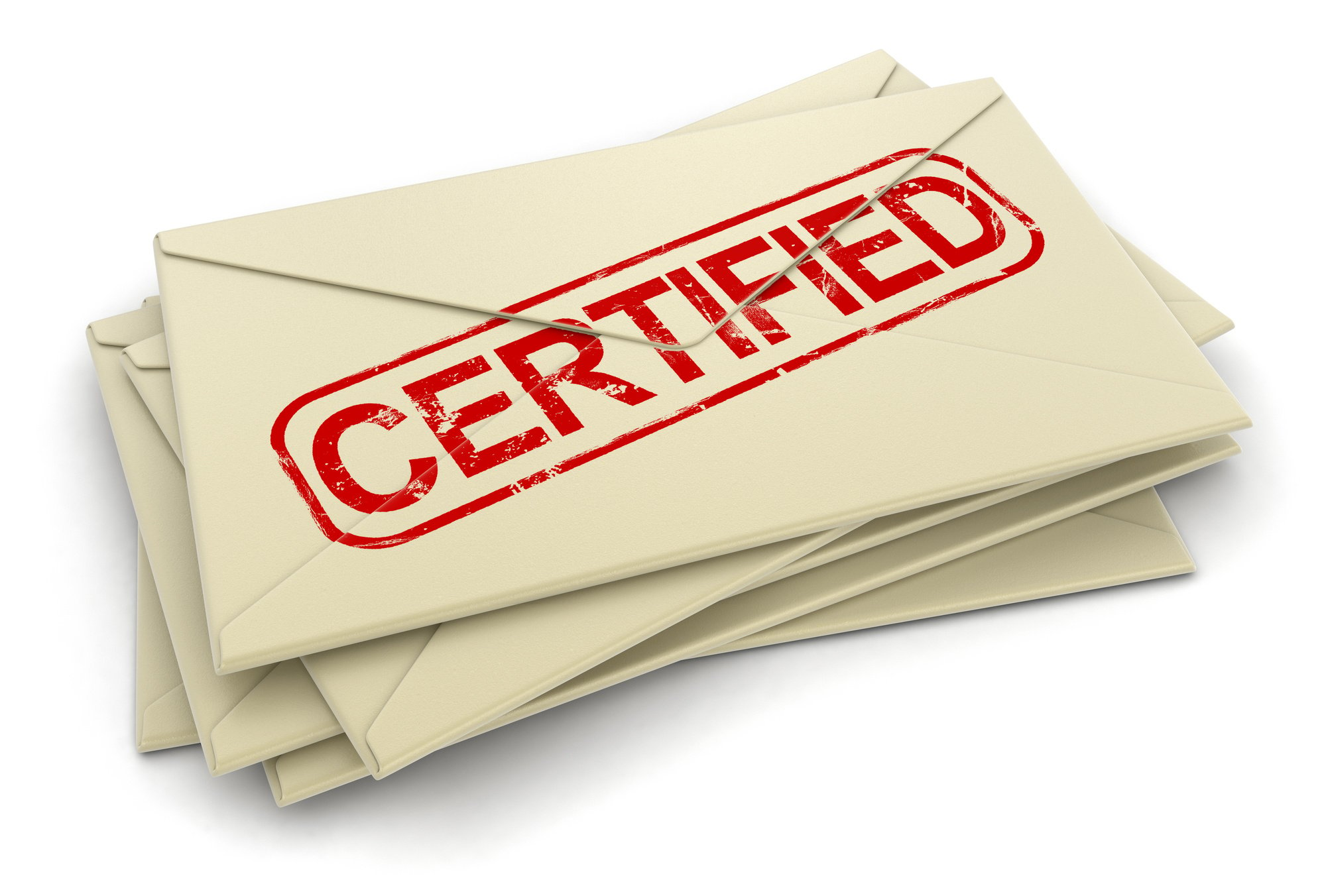According to the Government Accountability Office, the USPS lacks transparency when it comes to reporting delivery performance statistics. For most types of mail, it’s impossible to find statistics on how likely your letter is to arrive.
Sending a document via Certified or Registered Mail can increase your confidence. Which option should you choose, though?
Read on to learn more about the differences between Certified vs. Registered Mail.
Certified vs. Registered Mail
When you mail a document, you have three main options. These include regular First Class Mail, Certified Mail, and Registered Mail.
What Is First-Class Mail?
Regular First-Class Mail is the least expensive. Mailing a regular one-ounce document requires a single 55 cent stamp. If your letter weighs more than an ounce, it will require additional postage.
While inexpensive, First-Class Mail also offers the least peace of mind that your letter will arrive. Letters sent via First-Class Mail do not offer tracking information. They also do not include confirmation of delivery.
What Is Certified Mail?
“Certified” is a distinction added to a letter sent via First-Class Mail. By choosing the Certified option for your First Class Mail, you are opting for additional protections.
Certified Mail Cost
With Certified First-Class Mail, you will again need at least one 55 cent stamp. Businesses with postage meters pay 50 cents for the same postage. This postage covers packages weighing up to an ounce. Heavier letters require additional postage.
Currently, choosing the Certified Mail option for a First-Class letter costs an additional $3.55. This additional cost covers a Certified Mail Green Card.
Certified Mail Protections
Choosing Certified Mail can increase your peace of mind that your letter will arrive. Every piece of Certified Mail carries a tracking number. As the sender, you can use this tracking number to locate your piece of mail at any point in its journey.
The USPS also keeps a record of delivery for two years after the mailing date. This record includes the recipient’s signature upon delivery.
As the sender of a Certified Mail letter, you will not receive this record unless you opt—and pay—for a return receipt. If you opt for a return receipt, you have two options: electronic and paper.
An electronic return receipt arrives as a PDF in your inbox. It is convenient and eco-friendly. It is also cheaper than a paper receipt. Requesting an electronic return receipt on a certified letter costs an additional $1.70. A paper return receipt costs an additional $2.85.
Besides the additional cost, paper receipts have other drawbacks. They cannot be replaced or duplicated, for example. In contrast, you can print as many copies of an electronic receipt as you need.
If you choose not to add any return receipt, you can also print and use the tracking information as legal evidence.
Other add-on services for Certified Mail include restricted delivery options. With these options, you can require the mail carrier to leave your package only with the addressee. Alternatively, you can require that the package only be left with an adult over the age of 21.
Certified Mail Restrictions
You can select the Certified Mail option only for First-Class letters. It does not cover First-Class packages.
Certified Mail also only operates domestically. International letters cannot be sent Certified Mail.
Certified Mail, finally, is not insured. Once again, however, you can opt to include insurance for an additional fee.
What Is Registered Mail?
The most secure and most expensive option for mailing is Registered Mail. Letters sent via Registered Mail are kept separate from regular mail throughout their journeys.
Registered Mail Cost
Like Certified Mail, Registered Mail requires regular postage plus an additional fee. Registered Mail rates start at $12.60. However, the cost of sending a package via Registered Mail varies depending on the value of the shipment.
Registered Mail Protections
For the added cost, Registered Mail offers the greatest protection for your letter. Like a Certified letter, a Registered letter receives a tracking number.
Importantly, however, this tracking number is for the Post Office’s use. As the sender, you will not be able to follow your package during its journey.
With Registered Mail, you will receive confirmation—in the form of a return receipt and signature—when the package is delivered.
Between the time you send the package and the recipient accepts it, the USPS works to protect Registered Mail in a variety of ways.
First, the USPS keeps Registered Mail in a separate and secure location. When your letter is not in a mail carrier’s hands, it is secured in a safe, cage, or other sealed container.
Each time a piece of Registered Mail changes hands, moreover, the responsible individual signs for its receipt. Upon delivery, you’ll receive a receipt confirming your letter’s arrival.
As with Certified Mail, you can combine Registered Mail with other restricted delivery options. Again, you can require the mail carrier to leave your package only with the addressee. Alternatively, you can require that the package only be left with an adult over the age of 21.
Registered Mail Restrictions
Unlike Certified Mail, you can use Registered Mail to send letters or packages. You can also send Registered Mail domestically or internationally.
To ensure security, packaging for Registered Mail includes some specifications. You cannot send an item in a padded, self-sealing, or glossy envelope.
Acceptable sealants for Registered Mail include glue and cloth or paper tape. These sealants damage the packaging when they are opened. As such, they provide additional security throughout the chain of custody.
Finally, as with Certified Mail, insurance is not included in the base rate for Registered Mail. However, you can opt to insure your package for up to $25,000.
Using Certified or Registered Mail
Many people assume that choosing more secure mailing options requires more work on their part. To a certain extent, this is true. However, online options make sending secure items quick and convenient.
In fact, you can use Certified Mail without stepping foot in the post office. Two options make this possible:
- Pre-printed Certified Mail Envelopes
- Printable Certified Mail Labels
If you have a standard printer, you can essentially send Certified Mail online.
Simply set up an account with an online Certified Mailing service. From this account, you can order pre-printed envelopes or print your own Certified labels.
If you print your own labels, you’ll need to affix them to the envelope. Once you’ve done so securely, you’re ready to send your letter. You can do that by dropping it in any mailbox or by giving it to your mail carrier.
You can similarly print your own Registered Mail labels. However, Registered Mail does require a trip to the post office. You cannot simply drop a piece of Registered Mail in a mailbox.
Registered Mail vs. Certified Mail: Weighing Cost, Security, Speed, and Convenience
For a fee, Registered Mail and Certified Mail offer more secure options than regular First-Class Mail. The options are distinct, though. Depending on your priorities and preferences, one may be better than the other.
When to Choose Certified Mail
If you want more peace of mind than regular First-Class Mail provides but still aim to keep costs low, Certified Mail is likely your best bet. While Registered Mail rates begin at $12.60, the base fee for Certified Mail is only $3.55.
Certified Mail is also the more convenient of the two options. You can send a piece of certified mail without setting foot in the post office.
Another advantage of Certified Mail is that it allows you to track your letter using real-time updates. With a tracking number, you can find out where your Certified letter is at any point in its journey.
While the USPS tracks Registered Mail, you, as the sender, cannot access this information while your letter is out for delivery. You will, however, receive confirmation that your letter reached its destination.
Finally, if you are concerned about the delivery time, you may find Certified Mail is a better option.
Delivery estimates for both Certified and Registered Mail depend on the mail class you select. With the additional security protections Registered Mail entails, however, delivery can take longer.
When to Choose Registered Mail
If cost is no barrier and security matters most for your letter, Registered Mail may be the way to go. When you select Registered Mail, your package will travel through a documented chain of custody until it reaches the recipient.
When it is not in a designated person’s hands, moreover, it will be kept secure under lock and key.
If you are mailing a package and require added security, you’ll need to select Registered Mail. Certified Mail is an option only for mailed letters.
Registered Mail is also your only secure option if you’re sending a letter or package internationally. Certified Mail only operates domestically.
Choose the Best Secure Sending Option for Your Needs
According to the USPS motto, you can count on the service to deliver under any circumstances. Snow, rain, and heat are no obstacle to these faithful mail carriers.
Sometimes, though, human error is an obstacle. Even the most faithful mail carriers make mistakes. If you need additional assurances that your letter has made the journey, Certified and Registered Mail offer two options.
Understanding the advantages of Certified vs. Registered Mail helps you choose the best option for you.
As you explore your options for shipping and other communications needs, count on our blog for the most up-to-date advice.









